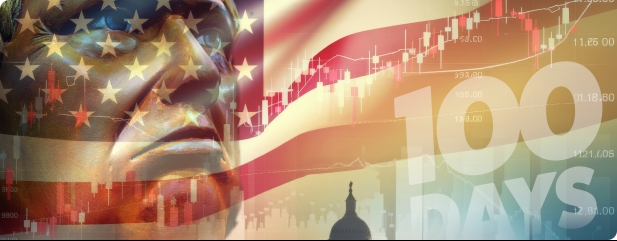Archived article
Please note that tax, investment, pension and ISA rules can change and the information and any views contained in this article may now be inaccurate.
Have Trump’s first 100 days taken us back to the 1970s?

Much as this column would like to offer something which does not mention words such as ‘Trump,’ ‘trade,’ and ‘tariffs,’ it is rather difficult to do so and at least the approach of the 100th day of the president’s second term in office gives us chance to take stock.
As we go to print, Trump’s second time in the White House looks set to give investors in US equities their roughest start to a new presidency since the Second World War, using the S&P 500 index as a benchmark.
This is a remarkable change of heart, given the rapturous welcome given to Trump’s election victory last November, when the S&P 500 (and the dollar) soared, while US Treasury yields remained stable. The imposition of blanket tariffs, an escalation of tensions with China and then a flurry of sidesteps and backtracks, as additional reciprocal levies are delayed, exemptions are provided for technology hardware and tentative olive branches are offered to Beijing leave everyone confused and are shaking investors’ prior strong faith in American exceptionalism.
The outperformance of US equity indices, the concomitant surge in the stock market capitalisation of the S&P 500 to an all-time high as a percentage of global market cap, and the lofty (and in some cases record high) earnings multiples applied to the US market all reflected how investors thought America was already great.
Their reassessment of this view shows in how US indices have retreated and taken valuation multiples lower. Now portfolio builders must wait to see if corporate earnings start to weaken to provide another challenge.
NIXON SHOCK
The good news is the data show a sticky start does not mean a presidency is doomed to provide poor returns over its full terms. The first stints in office for Truman and Eisenhower offer evidence for this. However, it is noticeable that the only presidencies which offered beginnings as weak as this one offer what may be uncanny echoes of current circumstances.
George W Bush took office in January 2001, just as the technology, media and telecoms bubble bull run turned into a massive bust. Investors fled as earnings disappointment, not to mention a rash of initial public offerings and secondary issues, persuaded them to realise valuation were untenably stretched.
None of this could be laid at Bush’s door and a difficult macroeconomic environment also made Nixon’s second term a treacherous one for US equity investors. However, this is where the echoes with current events get stronger still, thanks to the so-called Nixon shock of summer 1971. To help fund military conflict in Vietnam and welfare programmes at home, Nixon took the dollar off the gold standard, let the US currency slide and imposed tariffs on imports in an attempt to reset the global financial system to American advantage. An unexpected oil price spike in 1973, thanks to an Arab embargo in the wake of American support for Israel, complicated matters no end, but Nixon’s actions set off a chain of events that ushered in an era of inflation, if not stagflation, and misery (in real terms) for anyone who owned US equities, US bonds or cash – only gold and ‘real’ assets (commodities) provided a real bolt-hole.
TRUMP SHOCK?
Trump’s determination to lessen America’s trade deficit, weaken the dollar and re-set global trade terms smacks of Nixon’s plan, and also comes at a time when Federal finances hem in the president, albeit this time in the form of record borrowing levels rather than the straitjacket of the gold standard.
Investors must now answer two sets of (inter-related) questions. Do markets now feel less comfortable owning dollar-denominated assets, owing to the Trump presidency’s policies, how they are being implemented? If so, they may have further to fall as valuations are recalibrated lower to reflect such doubts and the scope for policy error and earnings disappointment. If not, the current chaos could indeed be a classic chance to ‘buy on the dip.’
Is the economic environment now going to be markedly different (as it was after the Nixon shock)? Since the Great Financial Crisis, low growth, low inflation and low interest rates have prevailed, to be benefit of long duration and secular growth and yield asset such as tech and biotech stocks and (long-dated) bonds. If the world is different, with more inflation, higher and more volatile interest rates and less predictable growth, is it not logical to expect different asset options to outperform? Gold (and commodities) may, again, be the best guide here.
Important information:
These articles are provided by Shares magazine which is published by AJ Bell Media, a part of AJ Bell. Shares is not written by AJ Bell.
Shares is provided for your general information and use and is not a personal recommendation to invest. It is not intended to be relied upon by you in making or not making any investment decisions. The investments referred to in these articles will not be suitable for all investors. If in doubt please seek appropriate independent financial advice.
Investors acting on the information in these articles do so at their own risk and AJ Bell Media and its staff do not accept liability for losses suffered by investors as a result of their investment decisions.
Issue contents
Feature
Great Ideas
Investment Trusts
News
- Investors eagerly await Berkshire Hathaway's Q1 and annual meeting on 3 May
- The US could be in for an unprecedented supply shock
- Imperial Brands shares hit a five-year high as investors dial down risk
- ITV receives takeover interest from French media giant Banjay
- Associated British Foods’ first-half results send shares skidding
- Winking Studios shares nearly halve year-to-date after IPO excitement
 magazine
magazine








